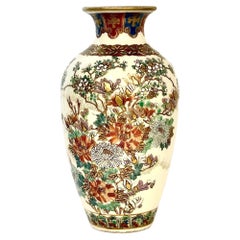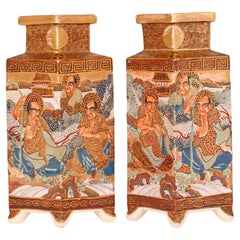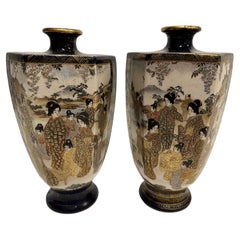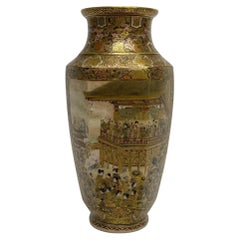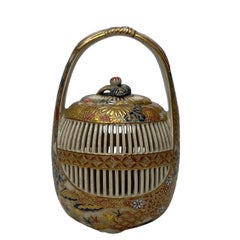Satsuma Ceramics
1
12
to
1
8
3
12
12
12
12
9
5
1
2
1
12
3
3
1
1
10
10
10
12
10
8
7
5
Period: 19th Century
Creator: Satsuma
Satsuma Imperial Vase "A Thousand Faces" Meiji Period
By Satsuma
Located in Autonomous City Buenos Aires, CABA
Satsuma Imperial Vase "A Thousand Faces" Meiji Period
A Japanese collectible vase, hand painted decorated with intricate designs and figures, with a classic shape and painted with va...
Category
19th Century Japanese Meiji Antique Satsuma Ceramics
Materials
Ceramic
Satsuma Japanese Meiji Miniature Enameled Teapot Kozon Mark
By Satsuma
Located in Bishop's Stortford, Hertfordshire
An exceptional Japanese Satsuma miniature spool shaped pottery teapot and cover finely hand enameled with Kozon mark and dating from around 1880. This delightful teapot has an invers...
Category
19th Century Japanese Meiji Antique Satsuma Ceramics
Materials
Pottery
Important Antique Japanese Meiji Satsuma Covered Urn Vase with Foo Dog
By Satsuma
Located in Atlanta, GA
We present an exceptional Satsuma porcelain urn or covered vase from the Japanese Meiji era (1868-1912). Its splendor and uniqueness are undeniable. The lidded jar is richly decorate...
Category
Late 19th Century Japanese Meiji Antique Satsuma Ceramics
Materials
Enamel
Antique Japanese Meiji Satsuma Painted Vase
By Satsuma
Located in LA CIOTAT, FR
A petite and beautiful hand-decorated ceramic baluster vase, painted all around with traditional Japanese motifs, including native flora, birds and bamboo stems on a creamy glazed background. The colour palette is bold and bright, with highlights of green, red and blue, together with plentiful gilt relief...
Category
19th Century Japanese Meiji Antique Satsuma Ceramics
Materials
Ceramic
Satsuma Japanese Meiji Pair Diamond Shaped Pottery Vases
By Satsuma
Located in Bishop's Stortford, Hertfordshire
A good and unusual pair antique Japanese Satsuma Meiji diamond shaped pottery vases decorated with monk figures with a scrolling dragon dating from the 1...
Category
19th Century Japanese Meiji Antique Satsuma Ceramics
Materials
Pottery
Pair of Blue Ground Japanese Satsuma Vases
By Satsuma
Located in Norwood, NJ
These are a very good quality pair of earthenware Japanese Satsuma vases, beautifully hand decorated and from the Meiji period, circa 1880. The vases...
Category
Late 19th Century Japanese Meiji Antique Satsuma Ceramics
Materials
Ceramic, Earthenware
Satsuma Earthenware Vase, by Kinkozan, Japanese, Meiji Period
By Satsuma
Located in West Palm Beach, FL
A Satsuma Earthenware Vase,
by Kinkozan,
Japanese, Meiji period (1868-1912)
decorated in polychrome enamels and gilt over a clear, crackled glaze, delicately painted with ladies and men, the reverse with a flowering garden with sprays of flowers, the neck with geometric and floral designs, a band of kifu heads in silver and gilt above the foot, on a midnight-blue ground, signed Kinkozan zo...
Category
1860s Antique Satsuma Ceramics
Materials
Earthenware
19th Century Japanese Satsuma Porcelain Water Well Bucket, Wishing Well Vase
By Satsuma
Located in Vero Beach, FL
This Japanese porcelain vase is barrel shaped with a yolk handle. It is both finely and intricately hand painted. It pictures groups of scholars with scrolls dressed in elaborate brocade kimonos...
Category
Late 19th Century Japanese Meiji Antique Satsuma Ceramics
Materials
Porcelain
Japanese Meiji Period Satsuma Large Square Bowl Centerpiece
By Satsuma
Located in Vero Beach, FL
Japanese Meiji Period Satsuma large square bowl
Antique early Meiji Period 15" square with scalloped rim Satsuma bowl. Highly unusual and finely painted. ...
Category
19th Century Japanese Meiji Antique Satsuma Ceramics
Materials
Ceramic
Japanese Meiji Satsuma Finely Decorated and Gilded Scenic Box
By Satsuma
Located in Gainesville, FL
Japanese Meiji satsuma finely hand decorated and gilded box. The box depicts a different scene on each side. Marked with a maker's mark on the bottom.
Category
Late 19th Century Japanese Meiji Antique Satsuma Ceramics
Materials
Pottery
Satsuma Earthenware Vase and Cover, Japanese, Meiji Period
By Satsuma
Located in West Palm Beach, FL
A Satsuma Earthenware vase and cover,
Japanese, Meiji period, (1868-1912)
decorated in polychrome enamels and gilt over a clear, crackled glaze, delicately painted with samurai on ...
Category
1890s Antique Satsuma Ceramics
Materials
Ceramic
Early Japanese Satsuma Antique Vase
By Satsuma
Located in Atlanta, GA
An Satsuma ceramic stone ware vase, circa 19th century, around the end of the Edo and the beginning of Meiji period. In the form of a Classic garlic bottle whose prototype was from China, the white bodied piece is decorated with an early form of kin nishikide, the so called golden brocade, a palette of iron-red, blue, green, yellow, purple and black with golden highlight. The over glazed enamel paint shows a group of robed figures in a garden setting with a lion and three tigers. A transparent overall glaze shows very fine crackles. The design is relatively sparse with plenty of negative space in contrast to the Satsuma production from the late 19th century, when the trend became fussy and overly glitz, due to the influence by the perceived western taste for the export market. This piece may still be made for export but its pattern was more influenced by both Kyoto Pottery and the Kano school of painting compared to the export ware by the end of the 19th century onward to the early 20th century. It was believed by many that this was a result of Satsuma potters visiting Kyoto in the late seventeenth century to learn over glaze painting techniques.
There are some age glaze crackles especially around the foot. The piece is not signed in keeping with the earlier production before Satsuma ceramics...
Category
Mid-19th Century Japanese Japonisme Antique Satsuma Ceramics
Materials
Ceramic
Related Items
Kutani Japanese Meiji Porcelain Vase Painted with Figures
Located in Bishop's Stortford, Hertfordshire
Japanese Meiji porcelain Kutani vase hand painted with decorative and a figural panel dating between 1868 and 1912. The elegantly shaped tall ...
Category
19th Century Japanese Meiji Antique Satsuma Ceramics
Materials
Porcelain
A pair of large Meiji period Satsuma Rouleau vases
Located in London, GB
A pair of large Meiji period Satsuma Rouleau vases
Japanese, Late 19th Century
Height 54.5cm, diameter 24cm
These beautiful Satsuma-ware vases were made ...
Category
Late 19th Century Japanese Meiji Antique Satsuma Ceramics
Materials
Earthenware
Satsuma earthenware vase by kinkozan, Meiji period
By Kinkozan
Located in Tel Aviv - Jaffa, IL
the body of this small marvelous vase is painted with a scene of a puppet show vendor with his wood backpack, on top of the backpack there are toys and dolls, he is surrounded with a group of 6 children, and on the background you can see a village.
on the other side of the vase there is an amazing painting of flowers and on the sides there are two amazing strong pine trees, the amorphous background is decorated in a "Tortoiseshell" color and design that gives it a real character and which is quite rare to see on satsuma pottery.
all the vase is over richly overpainted over the glaze with gold, which gives it its depth and realism.
signed Kyoto Kinkozan zo, and sealed Kinkozan zo
Kyoto’s Satsuma:
The painting technique used in Kyoto’s Satsuma-style ware is said to be the invention of the sixth generation Kinkōzan Sōbei (1824–1884). The Kinkōzan were a famous family of Kyoto Awataguchi potters who made ceramics that were used at Shōren'in, a temple closely tied to the imperial family, and by the shoguns of the Edo government. In fact the shogun is said to have granted them the name Kinkōzan. With the upheavals at the end of the Edo period, however, and the reforms of the subsequent Meiji government, the potters lost their traditional patrons and had to develop new markets.
Just at that time, the visit of a certain Westerner is said to have decided them to embark on overseas trade. By 1870, they had perfected Kyō Satsuma...
Category
1890s Japanese Meiji Antique Satsuma Ceramics
Materials
Gold
Japanese Satsuma Ginger Jar Vase, circa Early 20th Century
Located in New York, NY
A beautiful small Japanese Satsuma ginger jar vase, circa early-20th century, Japan. Colors include cream, copper, green, blue, white, black, orange...
Category
Early 20th Century Japanese Meiji Satsuma Ceramics
Materials
Ceramic, Earthenware, Pottery
Japanese Antique Satsuma Pottery Buddhist Monks Vase with Shimazu Crest Mark
By Satsuma
Located in Studio City, CA
A beautiful Japanese Satsuma pottery studio vase featuring multiple kesa-clad enlightened Buddhist monks on each side of the vase. The piece is finely detailed with rich raised gilt highlights throughout and beautifully decorated in gold and various hand painted other colors.
From the Meiji period (1868-1912).
This piece has the all-important Shimazu Family crest mark (red circle with a cross inside) on the base authenticating the work as an old and original Satsumaware work. The mark shows the pottery was made under the rule of the Shimazu clan.
From a Los Angeles Collection...
Category
Early 20th Century Japanese Meiji Satsuma Ceramics
Materials
Earthenware, Pottery
H 11.5 in W 4.5 in D 4.5 in
Meiji Period Diminutive Satsuma Baluster Vase.
By Satsuma
Located in Vero Beach, FL
Meiji Period Diminutive Satsuma Baluster Vase.
This Japanese Satsuma vase from the late Meiji period is hand painted and gilt decorated with a Japanese landscape in exquisite detail...
Category
20th Century Japanese Meiji Satsuma Ceramics
Materials
Porcelain
Antique Japanese Satsuma Miniature Cabinet Vase
By Master Ryozan
Located in Philadelphia, PA
A fine diminutive, antique Japanese Satsuma pottery cabinet vase.
Decorated throughout with gilding and raised enamel.
There are...
Category
20th Century Japanese Meiji Satsuma Ceramics
Materials
Ceramic
Satsuma Earthenware Vase, by Kinkozan, Japanese, Meiji Period
By Satsuma
Located in West Palm Beach, FL
A Satsuma Earthenware Vase,
by Kinkozan,
Japanese, Meiji period (1868-1912)
decorated in polychrome enamels and gilt over a clear, crackled glaze, delicately painted with ladies and men, the reverse with a flowering garden with sprays of flowers, the neck with geometric and floral designs, a band of kifu heads in silver and gilt above the foot, on a midnight-blue ground, signed Kinkozan zo...
Category
1860s Antique Satsuma Ceramics
Materials
Earthenware
19th Century Japanese Satsuma Porcelain Water Well Bucket, Wishing Well Vase
By Satsuma
Located in Vero Beach, FL
This Japanese porcelain vase is barrel shaped with a yolk handle. It is both finely and intricately hand painted. It pictures groups of scholars with scrolls dressed in elaborate brocade kimonos...
Category
Late 19th Century Japanese Meiji Antique Satsuma Ceramics
Materials
Porcelain
H 5 in W 4.13 in D 4.13 in
Pair of Porcelain Japanese Satsuma 'Moriage' Gilt Vases
By Satsuma
Located in LA CIOTAT, FR
This handsome pair of 20th century glazed and gilded Japanese Satsuma vases, with their vivid, jewel-like colours and elegant baluster-shaped forms, feature the traditional Japanese ...
Category
20th Century Japanese Satsuma Ceramics
Materials
Porcelain
Japanese Meiji Period Satsuma Bowl Signed Suizan
Located in Newark, England
Japanese Meiji period satsuma scalloped shaped bowl. The bowl of beautiful form with gilt pin-striping and dotting to the accented areas. The exterior decorated with multiple fish swimming around the outside with small flower sprays between. To the inside a painted netting covers the bowl with butterflies and further floral sprays. The centre decorated with representations of each of the woodcut prints from Hiroshige's Tokaido gojusan tsugi (53 Stations of the Tokaido Road). To the base a stylised cartouche signature within an oval for Suizan.
This Japanese satsuma bowl...
Category
Late 19th Century Japanese Meiji Antique Satsuma Ceramics
Materials
Ceramic, Earthenware, Pottery
Antique 19th Century Japanese Satsuma Vase Japan Arhat Figures Meiji Period
Located in Amsterdam, Noord Holland
Fabulous Japanese Satsuma vase.
Marked Base:
??? Dai-Nippon ?? Satsuma ?? Kikkoen 2
Condition
Overall condition perfect. Size 90 x 55mm
Period
Meiji Periode (1867-1912).
Category
19th Century Japanese Meiji Antique Satsuma Ceramics
Materials
Earthenware
Previously Available Items
Satsuma pottery vase, signed Chikuzan, Meiji Period.
By Satsuma
Located in Gargrave, North Yorkshire
Satsuma pottery vase, signed by Chikuzan, Japan, c. 1890, Meiji Period. The hexagonal shaped vase, well painted with a panel containing numerous figures attending a gathering at a te...
Category
1890s Japanese Meiji Antique Satsuma Ceramics
Materials
Earthenware
Imperial Satsuma cricket cage, Japan, c. 1880, Meiji Period.
By Satsuma
Located in Gargrave, North Yorkshire
A fine Imperial Satsuma pottery cricket cage, and cover, c. 1880, Meiji Petiod. The reticulated cage, modelled as a length of fabric, tied with a knot, which forms the overhead handl...
Category
1880s Japanese Meiji Antique Satsuma Ceramics
Materials
Earthenware
Imperial Satsuma pottery and silver koro, Japan, Meiji Period.
By Satsuma
Located in Gargrave, North Yorkshire
Imperial Satsuma pottery koro and silver cover, c. 1890, Meiji Period. The globular body, raised upon three scroll feet, and having a reticulated neck, consisting of interlinked circ...
Category
1870s Japanese Meiji Antique Satsuma Ceramics
Materials
Earthenware
Satsuma Pottery Figure ‘Hotei’, Japan, C. 1890, Meiji Period
By Satsuma
Located in Gargrave, North Yorkshire
Satsuma pottery figure group, Japan, c. 1890, Meiji Period. The large group, modelled as Hotei standing, with his corpulent belly sticking out of his robes. He drags his large sack, ...
Category
1890s Japanese Meiji Antique Satsuma Ceramics
Materials
Earthenware
Museum Quality Antique Japanese Satsuma Signed by Kinkozan, Meiji Era
By Satsuma
Located in London, GB
A museum quality satsuma miniature pear single-stem vase.
By Kinkozan, Meiji era (1868-1912), late 19th century.
Decorated in predominantly in gold enamels with a writhing three-cl...
Category
Late 19th Century Japanese Antique Satsuma Ceramics
Materials
Ceramic
Imperial Satsuma Vase, Signed Gyokusen, Meiji Period
By Satsuma
Located in Gargrave, North Yorkshire
Imperial Satsuma vase, signed Gyokusen, Japan, Meiji Period. The hexagonal shaped vase painted with a panel of a seated Shi Shi dog, beneath a floweri...
Category
1870s Japanese Meiji Antique Satsuma Ceramics
Materials
Earthenware
Satsuma Pottery Vase, Festival Gathering, Signed Zenkozan, Meiji Period
By Satsuma
Located in Gargrave, North Yorkshire
Satsuma pottery vase, of large size, signed Zenkozan, Meiji Period. Painted to the body with crowds of people attending a Festival, in extensive gardens, and before pavilions. Groups...
Category
1890s Japanese Meiji Antique Satsuma Ceramics
Materials
Earthenware
Satsuma Pottery Bowl, ‘Millefleur’ Pattern, Hozan, Meiji Period
By Satsuma
Located in Gargrave, North Yorkshire
Satsuma earthenware bowl, signed Hozan, c. 1900, Meiji Period. The large chrysanthemum shaped bowl, well painted both internally, and externally, with a profusion of flowering plants...
Category
1890s Japanese Meiji Antique Satsuma Ceramics
Materials
Earthenware
Imperial Satsuma Pottery Vase, c. 1880. Meiji Period
By Satsuma
Located in Gargrave, North Yorkshire
Fine Imperial Satsuma pottery vase, c. 1880, Meiji Period. The baluster shaped vase, hand painted in bold enamels, and heavy gilt, with a scene of a J...
Category
1880s Asian Meiji Antique Satsuma Ceramics
Materials
Earthenware
Satsuma Miniature Dish, Processional Boys, Keizan, Meiji Period
By Satsuma
Located in Gargrave, North Yorkshire
Satsuma pottery miniature dish, painted by Keizan, Meiji period. Hand painted to a central roundel, with a scene of boys in a procession, one riding a hobby horse.
The broad border ...
Category
1890s Antique Satsuma Ceramics
Materials
Earthenware
Imperial Satsuma Earthenware Plaque, circa 1870, Meiji Period
By Satsuma
Located in Gargrave, North Yorkshire
Imperial Satsuma earthenware plaque, circa 1870, Meiji Period. The foliate moulded plaque, hand painted with flowering plants, in typical enamels and ...
Category
1870s Japanese Meiji Antique Satsuma Ceramics
Materials
Earthenware
Satsuma Pottery Squared Vase, Kinkozan, circa 1890, Meiji Period
By Satsuma
Located in Gargrave, North Yorkshire
Satsuma pottery vase, circa 1890, Meiji Period. The large, squared shaped vase painted with four circular panels. One panel painted with a family before a river, the reverse panel wi...
Category
1890s Japanese Meiji Antique Satsuma Ceramics
Materials
Earthenware
Satsuma ceramics for sale on 1stDibs.
Satsuma ceramics are available for sale on 1stDibs. These distinctive items are frequently made of ceramic and are designed with extraordinary care. There are many options to choose from in our collection of Satsuma ceramics, although brown editions of this piece are particularly popular. If you’re looking for additional options, many customers also consider ceramics by Makuzu Kozan, Imari Porcelain, and Kinkozan. Prices for Satsuma ceramics can differ depending upon size, time period and other attributes — on 1stDibs, these items begin at $580 and can go as high as $1,726, while a piece like these, on average, fetch $1,111.
Creators Similar to Satsuma
Questions About Satsuma Ceramics
- What is a Japanese Satsuma vase?1 Answer1stDibs ExpertOctober 12, 2021A type of Japanese pottery originated from Satsuma province in Japan is termed as Satsuma ware. A vase of this kind is known as a Satsuma vase. An interesting fact about Satsuma ware is that they feature a "makers mark" or marking as a key to help collectors unlock the value, age and authenticity of the piece. Shop a range of antique and vintage Japanese vases on 1stDibs.
- How do I date a Satsuma vase?1 Answer1stDibs ExpertMarch 22, 2022To date a Satsuma vase, study its mark. Vases made before World War II normally feature a mark in Japanese. A vase that says "Royal Satsuma" likely dates back to the late 20th century. You'll find a variety of expertly vetted Satsuma vases on 1stDibs.
- 1stDibs ExpertApril 5, 2022Satsuma porcelain or pottery includes a maker’s mark with the name of the person who made the item. Japanese numbers may also indicate that a Satsuma piece was part of a collection. Genuine Satsuma pieces will not have a “Made in Japan” label and should only include Japanese characters. When in doubt, work with a certified appraiser to determine the authenticity of your Satsuma piece. Find a variety of expertly vetted Satsuma porcelain and pottery collectibles on 1stDibs.
- Is Satsuma pottery valuable?1 Answer1stDibs ExpertApril 26, 2024Yes, some Satsuma pottery is valuable. The age, type, style and condition will determine how much a particular piece is worth. In addition, the history of ownership may also make a piece more valuable. For example, if a piece was previously in the collection of a notable person, such as a member of the Japanese Imperial Family, it may be worth more. To get an estimated value for a particular piece, consult a certified appraiser or knowledgeable antiques dealer. Find a range of Satsuma pottery on 1stDibs.
- 1stDibs ExpertFebruary 1, 2024One way to tell if your Satsuma vase is valuable is to look for markings on it. The oldest and typically most expensive pieces will usually have the Shimazu family crest — a circle with a cross through it — hand-painted on the bottom. If the piece is stamped with the marking or says "Made in Japan" in the Roman alphabet, it is a newer vase. Factors like the style of the vase and its condition will also impact its price. It's a good idea to have a certified appraiser or knowledgeable dealer evaluate your vase to determine its value. Find a variety of Satsuma vases on 1stDibs.



